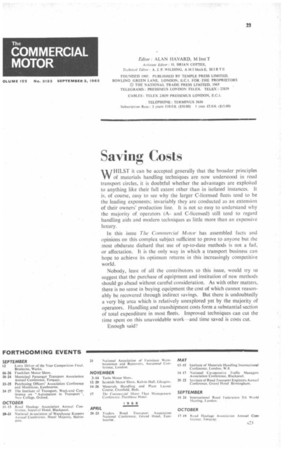Saving Costs
Page 25

If you've noticed an error in this article please click here to report it so we can fix it.
WHILST it can be accepted generally that the broader principles of materials handling techniques are now understood in road transport circles, it is doubtful whether the advantages are exploited to anything like their full extent other than in isolated instances. It is, of course, easy to see why the larger C-licensed fleets tend to be the leading exponents: invariably they are conducted as an extension of their owners' production line. It is not so easy to understand why the majority of operators (Aand C-licensed) still tend to regard handling aids and modern techniques as little more than an expensive luxury, ln this issue The Commercial Motor has assembled facts and opinions on this complex subject sufficient to prove to anyone but the most obdurate diehard that use of up-to-date methods is not a fad, or affectation. It is the only way in which a transport business can hope to achieve its optimum returns in this increasingly competitive world.
Nobody, least of all the contributors to this issue, would try to suggest that the purchase of equipment and institution of new methods should go ahead without careful consideration. As with other matters, there is no sense in buying equipment the cost of which cannot reasonably be recovered through indirect savings. But there is undoubtedly a very big area which is relatively unexplored yet by the majority of operators. Handling and transhipment costs form a substantial section of total expenditure in most fleets. Improved techniques can cut the time spent on this unavoidable work—and time saved is costs cut.
Enough said?




























































































































































